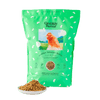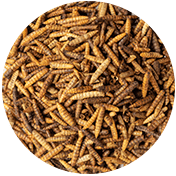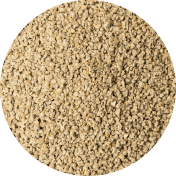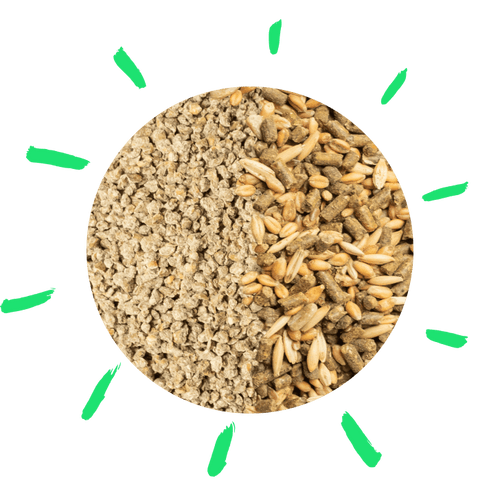When you’re expanding your fluffy family, you want all of your pets to get along. When it comes to introducing dogs and chickens, this means setting them up for success by preparing and taking the right steps to keep everyone safe. Luckily, there are some proven techniques and tips that make the process easier. From recognizing prey-drive instincts cues from your dog to giving your dogs ample time to meet their new feathered friends, this guide will walk you through the process.
What Chicken Breeds Pair Well with Dogs
Becoming a flock owner is a big decision–especially when your goal is to have your whole herd live in harmony. One way to increase your odds of long-term kinship between your dogs and chickens is to select a chicken breed with a reputation for getting along well with their canine companions.
When choosing a backyard chicken breed, aim for one known for their friendly demeanor and docile temperament. These include:
- Silkies
- Sebrights
- Brahmas
- Cochins
- Easter Eggers
- Orpingtons
- Speckled Sussex
Of course, having a flock with friendly characteristics is just the beginning of ensuring your hens and hounds live in peace.
Dog Breeds: Flock Friend or Foe?
Understanding your dog’s disposition can do wonders for successful dog-chicken introductions. If you’ve had your dog for several years, you can likely predict if they’re going to dart after a squirrel should the occasion arise or spend their time lounging in the sun without a care in the world.
However, if your dog is a recent addition to the family, their breed can provide major insight into how they’ll do as a chicken keeper. In fact, even if you feel you know your dog better than he knows himself, reviewing their breed’s disposition for flock friendliness can give you peace of mind—or provide you with a reminder that even the sweetest family dog can be excitable around chickens.
Dog breeds that pair best with chickens:
- Tibetan Mastiff
- Great Pyrenees
- Australian Shepherd
- Corgi
- Border Collie
- Shetland Sheepdog
- Old English Sheepdog
- Akbash
- Maremma Sheepdog
Keep in mind that every dog is a unique individual, and just because their breed is known for being cool, calm, and collected around chickens, your dog may not be. So, training and gradual introductions are best.
Dogs that may not be ideal chicken companions:
- Greyhounds
- Whippets
- Yorkies
- Jack Russells
- Terriers
- Labradors*
- Retrievers*’
- Huskies
Again, just because your dog’s breed has a reputation as not being the best chicken buddy, doesn’t mean that training won’t allow for them to live in peace with your flock.
*As for Labradors and Retrievers, they’re often great with chickens or truly struggle due to their history as bird dogs and hunting dogs.
Introducing Your Dogs to Chicks and Chickens

Being in the right mindset is vital for you and your dog when going into any training session. So, keep in mind the basics. Throughout the introduction process, focus on positive reinforcement by rewarding your dog with praise, treats, and affection. Don’t overwhelm your dog by training for more than ten to fifteen-minute sessions at a time.
Dog-Chick Interaction Training
Whether you’re ordering chicks online or buying them locally, begin prepping your home and dog as early as possible. The more time you have to prepare, the better. Additionally, be sure your chicks and your canine companion are all healthy before allowing them to interact. This will reduce the risk of transmitting illness between the critters and reduce the risk of your dog lashing out should they not feel well.
Step 1: Prepare Your Space
Your chicks and dog will have to share space. Preparing and planning how they’ll share space, especially in the first few weeks and months of your chicks’ lives, makes managing your dog-chick introduction a lot easier.
Before setting up your brooder, consider where your dog spends the majority of their time in your home. Allow your dog to maintain this space as their own.
Your chicks will be quite noisy. Their peeps and rustling about can be quite exciting for most dogs. Additionally, you want your chicks to have a safe and secure location where your dog can’t access them unsupervised. Additionally, your chicks will appreciate a place where they can rest and relax. Consider setting up your brooder in your laundry room, an office, or a guest bedroom. Before your chicks arrive, begin keeping the door to this room shut. This will reduce your dog’s curiosity and lessen the impact of a sudden change to your dog’s normal environment.
Set Up Your Coop & Run
Keeping with the theme of one change at a time, we recommend you set up your coop before your chicks arrive. This will give your dog time to adjust to seeing the coop, and give you one less task to worry about once your chicks arrive.
Just as your dog’s indoor space is their own, keep your chicken’s coop and run as their own, too. Establishing this boundary before the arrival of your chicks will reduce complications later on.
Step 2: Practice Before Your Chicks Arrive
Dogs with foundational obedience training often do best when it comes to learning boundaries with new chicks. If your dog has yet to learn to sit, stay, and drop it, you may want to postpone ordering your chicks until they do.
If your dog has these commands down pat, they’re starting off on the right paw to be a great chicken sibling. In the weeks leading up to the arrival of your chicks, practice these commands, plus some more challenging ones to keep your dog’s obedience skills honed and ready to go.
We recommend three or more training sessions per day to keep your dog in the training mindset.
Step 3: Pre-Meeting and the First Meet-and-Greet
Once your chicks arrive, you will want to bring them in without alerting your dog. Keeping your canine companion in another room or in your fenced backyard will do the trick. Next, transfer them to their brooder and provide them with fresh water and feed.
After your chicks are situated, you should close the door to their room. Afterward, you will want to let your dog smell your hands. This is your dog’s first ‘introduction’ to your chicks.
At this point, building your relationship with the chicks takes priority. As your chicks get to know you and trust you, they will remain calmer when the time comes to meet their dog brother or sister. Take a week to three weeks to bond with your chicks before your dog’s face-to-face introduction with the chicks. But let your dog smell your hands after you spend time with the chicks.
Face-to-Face Introductions
Once your chicks are about a few weeks old, you can begin the steps for their face-to-face introduction to your dog. Take your dog on a long walk to get their excess energy out.
If you have a baby gate, put it up in the doorway and let your dog see the chicks through the gate. At this time, reinforce your dog’s training by practicing their commands outside the door. Remember your positive reinforcement and praise!
After a few sessions of “I-spy” time with your dog and the chick babies, you can let your dog officially meet one of the chicks. To do so:
- Put a leash on your dog (better safe than sorry). Having another set of hands helps with this and the snacks in steps 5 and 6.
- Ask your dog to sit and stay outside of the baby gate.
- Gently but securely pick up one of your chicks.
- Continue to ask your dog to stay as you make your way to your dog.
- Release your dog, give your dog a snack, then reposition them in a sit and stay position.
- Lower the chick and allow your dog to smell it. Praise your dog for staying calm, and speak softly to your chick, too. Providing each with snacks helps establish a positive association.
This is a very exciting moment for your dog. If you feel like your dog is struggling to remain still, return the chick and release your dog from their stay.
Step 4: Build on the Experience
Your dog’s first meet and greet set the tone you want to repeat. Be sure to give your dog plenty of time to calm down and recalibrate between sessions. Repeat the steps above while rotating out which chick you bring over to your dog.
As you work through this process, continue to provide both your dog and chicks with snacks to solidify the positive reinforcement between your pets.
You will want to continue to keep them separated for safety as your dogs and chicks build a relationship.
Step 5: Outdoor Introductions
Once your chicks are ready for their outdoor coop and run, the new environment can reframe them in your dog’s mind. This is even more emphasized if your dog has a high prey drive since your chicks will be able to run and walk more freely.
To continue to encourage your dog and chicks to get along, give your chicks a day or two to adjust to their new outdoor home. After they’ve adjusted, bring your dog out on a leash and practice their command to get your dog into the training mindset. Then, allow your dog to observe and smell the chicks through the fence of their chicken yard.
If your dog gets too excitable or reacts with unfriendly behavior or body language (such as stalking, perked ears, and growling), take your dog by the leash in the opposite direction of the yard. These signals mean it’s time to let your dog observe the chicks from afar as they practice their obedience. Over time, you can gradually move your dog closer to the coop, again.
Step 6: Practice Outdoor Boundaries
It can take months, even years, to get to a place where you can trust your dog to be alone with your chickens. Erring on the side of caution is always a good idea. However, if your goal is to allow your dog to mingle with your flock regularly, you will want to work on unleashed boundaries with your dog.
Your dog is ready to be off-leash once they stop reacting to the presence of the chickens. Once the chicks are no longer novel, your dog should begin seeing them more like siblings. This includes not charging at the fence and freely turning their head toward you when you call.
When you first allow your dog to interact with your hens off-leash, keep the sessions short–and always supervise. If everything goes well, continue positive praise for everyone involved.
If you hit a few hiccups along the way, use your judgment–and consider calling in a trainer if needed.
Step 7: Ongoing Relationship Fostering
Like all training, refresh sessions are a healthy way to remind your dog and chickens of healthy boundaries and behavior. Practicing new commands and some of your dog’s favorites in the presence of your flock is a great way to strengthen your dog’s concentration in unique circumstances.
As your flock grows, your hens will help to teach their chicks how to behave around your dog. If you expand your flock by ordering or purchasing local day-old chicks, you will want to repeat steps 3 and 4. While your dog may be accustomed to your chicks at this point, these steps help your chicks feel comfortable around your dog.
Introducing Your Dog to Adult Hens

The connection between dogs and chicks that they see grow into hens is a bit different than that between a dog and a new full-grown hen. Why? Hens are much larger, more imposing, and have full-grown personalities. And these attributes come with super-sized effects on your dog.
To introduce your dog to hens, follow these steps:
Step 1
For dogs that have never been around chickens, keep your new hens in their coop and run for the first week or so. This gives everyone the opportunity to see one another, safely.
Step 2
This step requires two people–one to handle your dog while the other handles a chicken. Once your coop with your adult chickens has lost its novelty to your dog, you can introduce your dog to one of the chickens. While one person should hold one of the chickens outside of the coop in a neutral part of the yard, the other can enter the backyard with your dog on-leash.
Approach the chicken with your dog, asking them to sit and stay about 10-feet away from the chicken. Continue to ask your dog to stay while your partner approaches with the chicken. Use positive affirmations to encourage your dog to stay calm.
Let your dog smell your chicken, and provide your dog with a snack to build a positive association. Return the chicken to the coop if your dog becomes restless or after a minute or so.
Step 3
Repeat step 2, switching out which hen your dog meets and increasing the interaction time. If all goes well over the course of about a week, you can let your dog smell your chicken without the leash.
Step 4
As your chickens and dog become more used to one another, and your dog has not presented any signs of wanting to act on their prey drive, you can let them interact freely. However, you will want to continue to supervise their interactions.
Puppies & Chickens

If you’re adding a new dog to your existing family and flock, a puppy can be a great choice. Because puppies absorb a ton of information in their first months of life, meeting chickens at this stage can set the precedent for years to come. Of course, you want to work on your puppy’s impulse control, recall, and manners throughout their puppyhood. Doing so in conjunction with your flock will solidify boundaries and appropriate chicken-puppy behavior.
Providing Your Flock a Safe Environment
Your priority as a flock-keeper is to always provide your chickens with a safe, secure environment. Even if your dog interacts positively with your flock, you want to ensure your coop and run are predator-proof. While it may seem uncommon, there are plenty of instances where stray dogs have broken into backyards as well as coops, wreaking havoc on chickens. A proactive approach to safety can reduce the risk of this happening to your flock.
If you are not 100% certain of how your dog will behave with your flock, do not allow your dog to interact with your flock unsupervised.
Sit, Stay, and Enjoy Your Fluffy Family
There are few joys as enriching as maintaining a happy, healthy flock that lives in harmony with your furry best friend. As you work with your dog, chickens, and chicks, keep your goal in mind and remember that slow-and-ready wins the race. Additionally, using positive reinforcement will ensure that your canine companion and chickens will build positive associations with one another that will last their lifetimes.



















